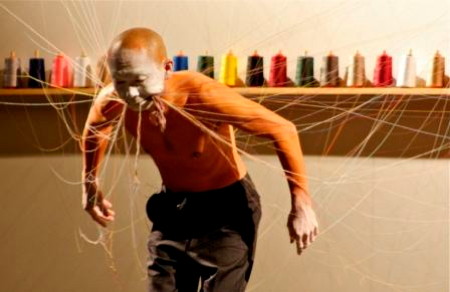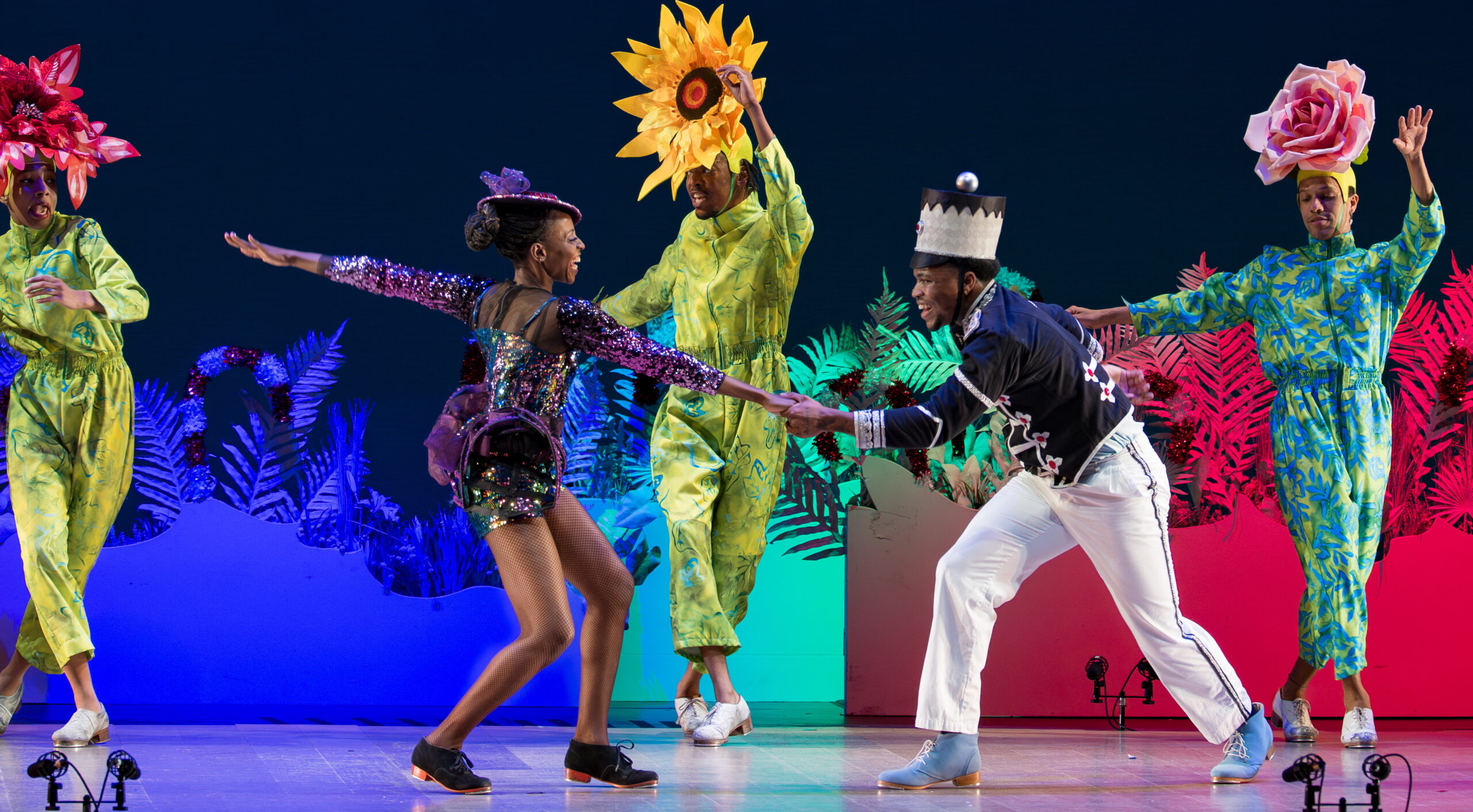Kicking off the Pacific Standard Time Performance and Public Art Festival, this major new site-specific commission by Hirokazu Kosaka transforms the Getty Center’s Arrival Plaza into a sculptural and performative installation. In this event, Kosaka builds a symbolic parallel between kalpa—a Sanskrit word that means “a long period of time”—and how it inevitably transforms our lives, histories, and memories.
On Friday, January 20, 2012, the Getty Museum will present this one-off performance by artist Hirokazu Kosaka along with the Los Angeles Free Music Society.
Using movement and music, Kosaka’s installation Kalpa will transform the Getty Center’s Tram Arrival Plaza with an enormous spotlight, Butoh dancers and hundreds of spools of colorful thread placed on a wall designed by architect Michael Rotondi.
In this performance, Kosaka builds a symbolic parallel between kalpa (meaning ‘eon’ in Sanskrit) and the inevitable passage of time that slowly transforms lives, histories and memories.
“It is believed in the Buddhist faith that once every hundred years, an angel comes down from heaven and swipes the surface of a stone with her silk sleeves until the rock disappears,” said Kosaka. “This idea comes into play in my performance, as it demonstrates the deliberate, unseen passage of time, and the tangible objects that we use to measure it.”
Kosaka is known for his large-scale pieces, which often use publicly accessible space as a platform for dance, performance, and visual art. Kosaka’s work has been performed at venues that include the Museum of Contemporary Art, Los Angeles; the Japanese American Theater, Los Angeles; the Seattle Art Museum; and the Indianapolis Art Museum.
Performers include Butoh master Oguri, who will lead a small company of dancers, musician and composer Yuval Ron, who will create the aural environment with a combination of live and recorded music and sounds, and harmonica player Tetsuya Nakamura.
Following the performance of Kalpa, the Los Angeles Free Music Society will present LAFMS Shoe on the Getty Museum’s outdoor courtyard stage. LAFMS Shoe is an ensemble comprised of many of the core members of the Los Angeles Free Music Society. The musicians will play a series of duets that seamlessly morph from musician to musician, exposing a constantly evolving palette of musical voices.
Kalpa and LAFMS Shoe will be presented on Friday, January 20, 2012, beginning at 7:00 p.m., outdoors at the Getty Center. The events are free, but reservations are required and are available beginning Tuesday, December 20, 2011 at 9:00 a.m. For reservations or more information, visit the official site or call (310) 440-7300.
The Pacific Standard Time Performance and Public Art Festival will take place from January 19 through 29, 2012, featuring more than 30 extraordinary performances—including contemporary re-enactments of iconic works by artists such as Judy Chicago, Suzanne Lacy, Robert Wilhite and James Turrell. Organized by the Getty Research Institute and LA><ART, and supported by grants from the Getty Foundation in conjunction with the ongoing Pacific Standard Time: Art in L.A. 1945-1980 initiative, the Performance and Public Art Festival will reexamine, reinvent, reinterpret and renew an epochal movement in contemporary art for which Los Angeles has been an epicenter.
About the Artist:
HIROKAZU KOSAKA
Born in Wakayama, Japan in 1948, Hirokazu Kosaka now lives and works in Los Angeles, where he serves as Visual Arts Director at the Japanese American Cultural and Community Center. As a student at the Chouinard Art Institute, where he graduated with a BFA in painting in 1970, Kosaka began to explore the art of performance, looking toward artists such as Wolfgang Stoerchle, Allen Ruppersberg, William Leavitt and Chris Burden for inspiration. As a young artist, Kosaka also began to incorporate Eastern traditions in his art, drawing from his appreciation of the centuries-old traditions of Noh drama and Kabuki theater, his knowlege of the ground-breaking experimental art of Japan’s Gutai Group in the mid-1960s, as well as his own experience with Buddhist chanting and Zen archery.
In 1973, Kosaka returned to Japan where he completed a three-month long performance piece called “Soleares” and later embarked upon a traditional 1,000-mile Zen pilgrimage called “The 88 Temples.” After completing this spiritual journey, Kosaka remained at a Buddhist monastery and was ordained as a Shigon Buddhist priest. He later returned to Los Angeles where he began to create large-scale, process-oriented artworks infused with the teachings he learned as a priest.
Today, Kosaka is known for his large-scale, performative pieces, which often use publicly accessible space as a platform for dance, performance, and visual art practice. Kosaka’s work has been seen and performed at venues including the Museum of Contemporary Art, Los Angeles; the Japanese American Theate, Los Angeles; the J. Paul Getty Center; the Seattle Art Museum; and the Indianapolis Art Museum. Selected grants and awards include a Creative Capital grant, a Rockefeller Foundation grant, a California Arts grant, and a Los Angeles Endowment for the Arts grant.
Kalpa and LAFMS Shoe
Friday, January 20, 2012,
7:00 p.m., outdoors at the Getty Center.
Getty Center
1200 Getty Center Drive
Los Angeles, California 90049
The events are free, but reservations are required and are available beginning Tuesday, December 20, 2011 at 9:00 a.m.
For reservations or more information, visit the official site or call (310) 440-7300.
The J. Paul Getty Trust is an international cultural and philanthropic institution devoted to the visual arts that includes the J. Paul Getty Museum, the Getty Research Institute, the Getty Conservation Institute, and the Getty Foundation. The J. Paul Getty Trust and Getty programs serve a varied audience from two locations: the Getty Center in Los Angeles and the Getty Villa in Malibu.
The J. Paul Getty Museum collects in seven distinct areas, including Greek and Roman antiquities, European paintings, drawings, manuscripts, sculpture and decorative arts, and photographs gathered internationally. The Museum’s mission is to make the collection meaningful and attractive to a broad audience by presenting and interpreting the works of art through educational programs, special exhibitions, publications, conservation, and research.
Visiting the Getty Center
The Getty Center is open Tuesday through Friday and Sunday from 10 a.m. to 5:30 p.m., and Saturday from 10 a.m. to 9 p.m. It is closed Monday and major holidays. Admission to the Getty Center is always free. Parking is $15 per car, but reduced to $10 after 5pm on Saturdays and for evening events throughout the week. No reservation is required for parking or general admission. Reservations are required for event seating and groups of 15 or more. Please call (310) 440-7300 (English or Spanish) for reservations and information. The TTY line for callers who are deaf or hearing impaired is (310) 440-7305. The Getty Center is at 1200 Getty Center Drive, Los Angeles, California.
About Pacific Standard Time: Art in L.A., 1945–1980
Pacific Standard Time is a collaboration of more than sixty cultural institutions across Southern California, coming together for six months beginning in October 2011 to tell the story of the birth of the Los Angeles art scene and how it became a major new force in the art world. Each institution will make its own contribution to this grand-scale story of artistic innovation and social change, told through a multitude of simultaneous exhibitions and programs. Exploring and celebrating the significance of the crucial years after World War II through the tumultuous period of the 1960s and 70s, Pacific Standard Time encompasses developments from L.A. Pop to post-minimalism; from modernist architecture and design to multi-media installations; from the films of the African-American L.A. Rebellion to the feminist activities of the Woman’s Building; from ceramics to Chicano performance art; and from Japanese-American design to the pioneering work of artists’ collectives. Initiated through $10 million in grants from the Getty Foundation, Pacific Standard Time involves cultural institutions of every size and character across Southern California, from Greater Los Angeles to San Diego and Santa Barbara to Palm Springs. Pacific Standard Time is an initiative of the Getty. The presenting sponsor is Bank of America.
Additional information is available here.
Sign up for e-Getty at www.getty.edu/subscribe to receive free monthly highlights of events at the Getty Center and the Getty Villa via e-mail, or visit www.getty.edu for a complete calendar of public programs.








